Key takeaways:
- Incorporating varied learning modalities, such as visual, auditory, and kinesthetic, enhances participant engagement and understanding in workshops.
- Identifying participants’ learning styles through informal assessments allows facilitators to tailor their approach, fostering a more inclusive environment.
- Techniques like gamification, storytelling, and offering choices in activities significantly boost motivation and connection among participants.
- Success in workshops can be measured through participant feedback, engagement levels, and knowledge retention, demonstrating the impact of diverse learning strategies.
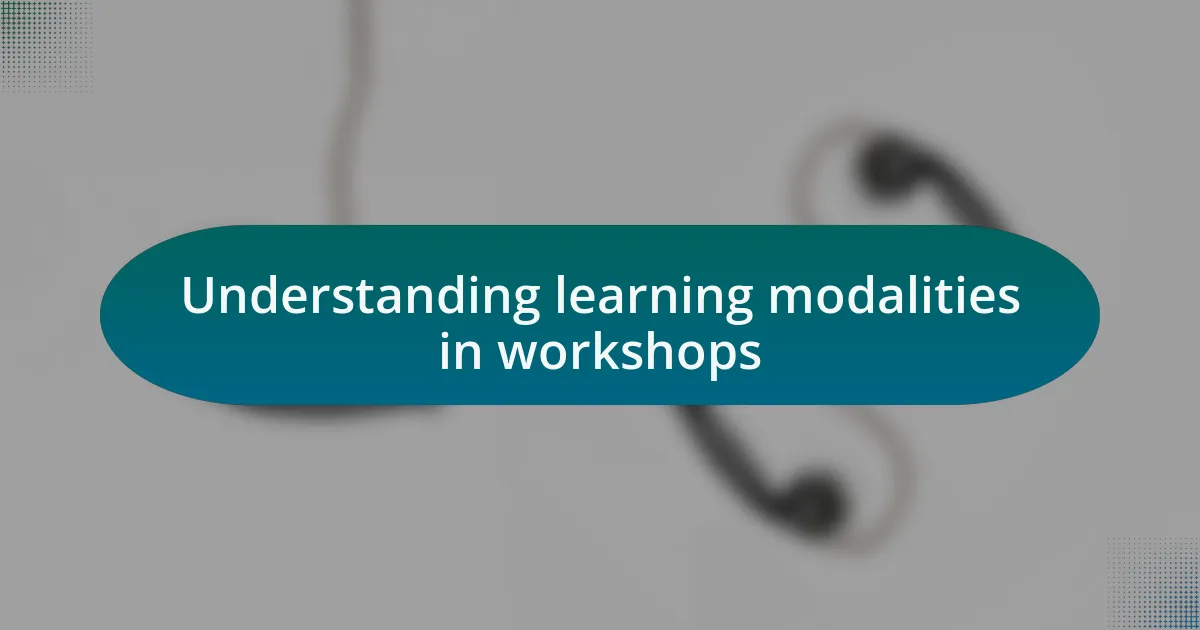
Understanding learning modalities in workshops
Understanding the different learning modalities in workshops is crucial for fostering an environment that resonates with everyone involved. I remember attending a tech workshop where an instructor seamlessly blended auditory explanations with visual presentations. Engaging with varied modalities helped me grasp concepts much quicker than if we had relied solely on one method.
When I reflect on my experiences, I often wonder: why limit ourselves to traditional teaching techniques? Incorporating kinesthetic learning—like hands-on activities—can invigorate a workshop. I noticed a remarkable difference when we were invited to work on a coding project in small groups. The collaborative atmosphere ignited our creativity and led to deeper comprehension of the subject matter.
It’s fascinating how different people absorb information uniquely. Some thrive on reading materials, while others find live demonstrations more impactful. I recall a participant in one of my workshops who thrived on visual cues yet struggled with lengthy lectures. By incorporating a variety of modalities, we create a rich tapestry of learning that not only respects these differences but amplifies the overall workshop experience.
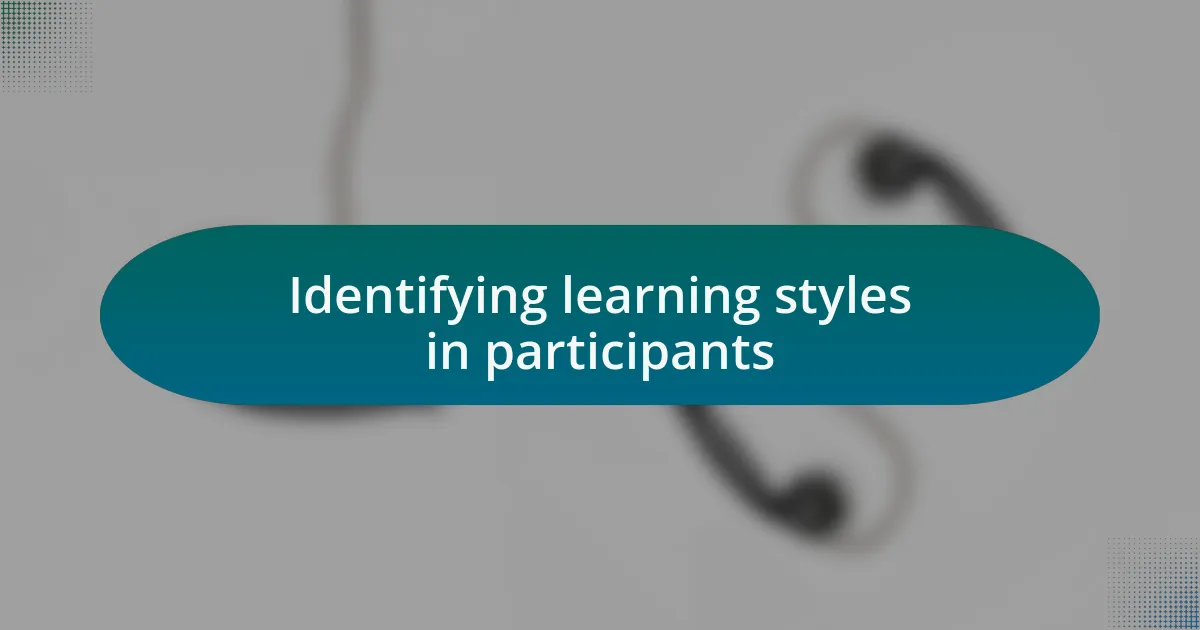
Identifying learning styles in participants
Identifying learning styles in participants requires a keen eye and a bit of intuition. While facilitating a tech workshop last year, I paid attention to how participants interacted with the material. I noticed some participants eagerly took notes during discussions, while others engaged more when we switched to interactive polls or group activities. This observation made me realize that a dynamic approach can illuminate the diverse learning preferences in the room.
One effective method I’ve found is to conduct quick, informal assessments at the beginning of a session. I once asked participants to jot down their preferred learning style—visual, auditory, or kinesthetic—on sticky notes. The results were enlightening! The responses created a visual map of our collective learning preferences and allowed me to tailor the workshop format on the fly. It felt rewarding to see participants respond positively to a setup that acknowledged their individual learning styles.
Ultimately, it’s about listening and adapting. In a recent workshop, a participant expressed feeling overwhelmed during extensive slideshows. This feedback reminded me to balance the presentation with discussion breaks, allowing me to gauge how everyone was absorbing the material. If we tune in to these signals, we can ensure that our workshops are engaging, inclusive, and effective for all.
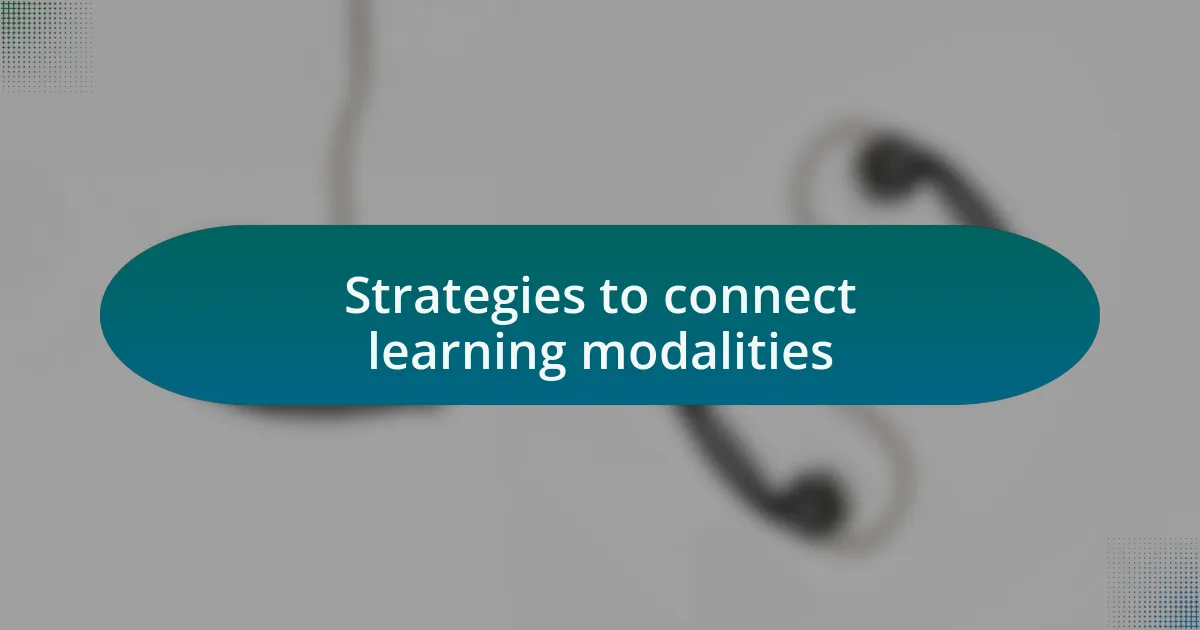
Strategies to connect learning modalities
One powerful strategy I’ve utilized is integrating multimedia elements to cater to different learning preferences. During one tech workshop, I introduced a mix of videos, live demonstrations, and hands-on activities. This not only grabbed attention but also allowed participants to connect with the content in a way that resonated with them. Have you ever noticed how a well-placed video can ignite discussion? It’s truly remarkable to see the energy shift in the room.
Collaborative learning exercises also play a crucial role in connecting various modalities. I remember a particular instance when I organized small group challenges that required participants to problem-solve together. By incorporating both auditory discussions and kinesthetic tasks, I witnessed a palpable synergy among the groups. Everyone became more engaged, and I could see the light bulbs going off as complex concepts became clearer through shared effort. Isn’t it exciting to witness that collective “aha” moment?
Finally, incorporating reflection activities is essential in solidifying learning across modalities. In one workshop, I encouraged participants to share their insights and takeaways at the end. This not only reinforced their experiences but also allowed me to gauge the effectiveness of my strategies. It’s fascinating how reflecting together can create a deeper understanding. Have you tried this in your sessions? The blend of modalities becomes not just a teaching method, but a shared journey toward knowledge.
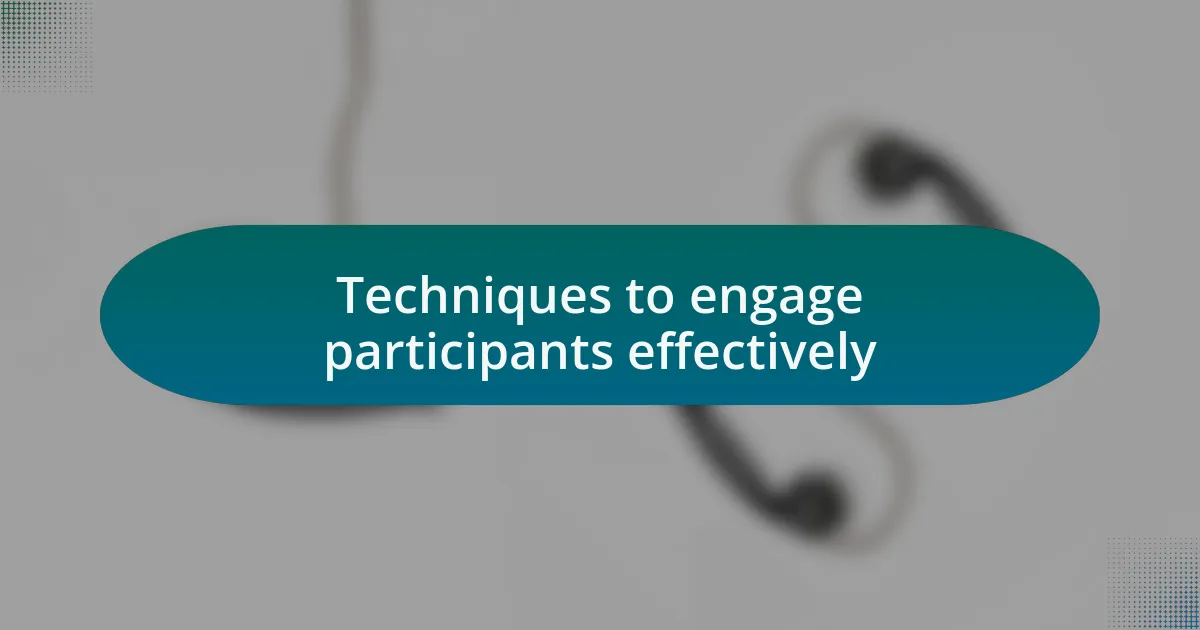
Techniques to engage participants effectively
One effective technique I’ve found is the use of gamification to spark excitement and motivation. In a coding workshop I conducted, I transformed routine exercises into friendly competitions, complete with points and rewards. This element of play not only encouraged participation but also created a vibrant atmosphere where laughter and creativity thrived. Who doesn’t love a bit of friendly rivalry to boost engagement?
Another approach is to use storytelling as a vehicle for discussion. I recall a time when I shared a personal experience related to a project failure, inviting others to share their stories afterward. This created an intimate space where participants felt comfortable opening up. It was striking to see how sharing personal narratives shifted the dynamics of the room, making learning more relatable and meaningful. Have you considered how stories can deepen connections among participants?
Finally, offering choice in activities significantly enhances engagement levels. During a workshop about emerging technologies, I provided a selection of breakout sessions tailored to different interests, such as hands-on coding, design thinking, and user experience strategies. I was amazed at how participants gravitated toward what truly excited them. It made me realize that when people feel empowered to choose their learning path, they become more invested and enthusiastic about the content. Isn’t it rewarding to see that transformation?
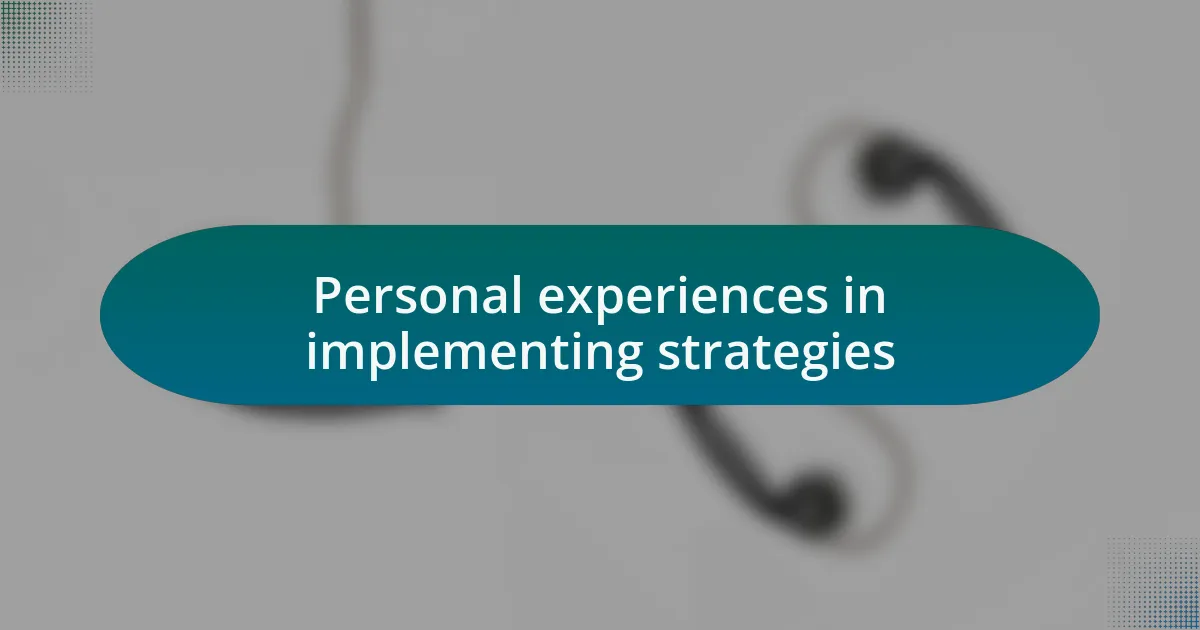
Personal experiences in implementing strategies
When I first began integrating different learning modalities into my workshops, I was a bit skeptical about how well these strategies would work. I remember designing a hands-on coding session by combining video demonstrations with live problem-solving, and the results were fascinating. Seeing participants light up when they successfully solved a challenge after visual engagement was a moment I’ll never forget. It made me appreciate how multimodal learning fosters that “aha” moment.
One experience that stands out occurred during a workshop where I employed visual aids to enhance understanding. I crafted infographics that simplified complex concepts, and as I watched participants interact with those visuals, I realized just how powerful they can be. Occasionally, someone would pause to ask a question about a specific detail in the graphic, revealing a deeper level of curiosity. Doesn’t it feel great when participants take the initiative to dive deeper?
Another memorable occasion was when I facilitated a collaborative project that utilized role-playing to embody user personas. The energy in the room shifted dramatically. Participants not only stepped outside their comfort zones but also expressed empathy towards the end users they were representing. This shift made me wonder: how often do we create spaces for such profound connection? It taught me that incorporating diverse methods can transform learning into an immersive journey rather than a mere lecture.
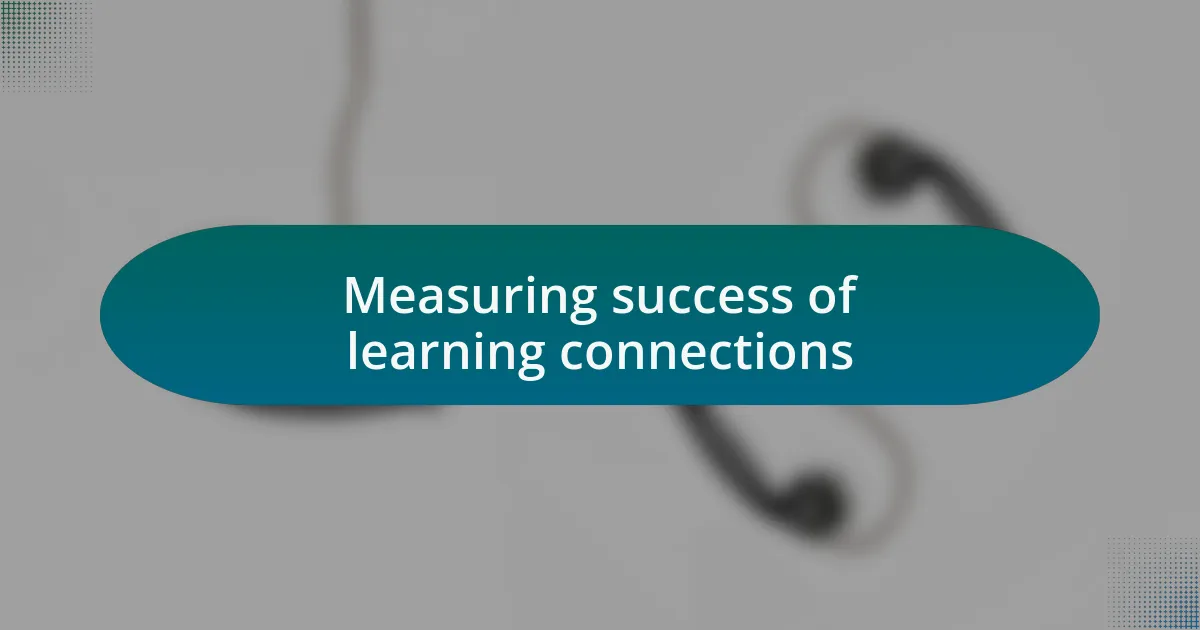
Measuring success of learning connections
Measuring the success of learning connections often feels like trying to capture lightning in a bottle. One time, I introduced a quick feedback loop after a workshop session. Participants shared their experiences on sticky notes, and it was incredible to see how many highlighted their favorite learning modality. A few declared that the combination of auditory and kinesthetic elements made a significant difference in their understanding. Can you imagine how that kind of direct feedback can guide future sessions?
When I analyze the outcomes of my workshops, I often look at participant engagement levels, as well. For instance, during a recent session, I introduced short breakout discussions coupled with shared digital tools. The room buzzed with energy; people were not only engaging with the content but also with each other. The conversations flowed seamlessly, illustrating how interaction can enhance learning. Isn’t it interesting how real-time dialogue can clarify concepts far beyond passive listening?
Success can also be measured through the extent of knowledge retention. After incorporating various learning modalities, I witnessed a notable improvement in participants’ abilities to recall key concepts in follow-up sessions. One participant even shared that they could apply what they learned to real-life projects — a clear indicator of meaningful connection. How often do we get to witness our teachings ripple into tangible outcomes in the tech industry? It’s moments like these that validate the effort put into integrating diverse modalities.